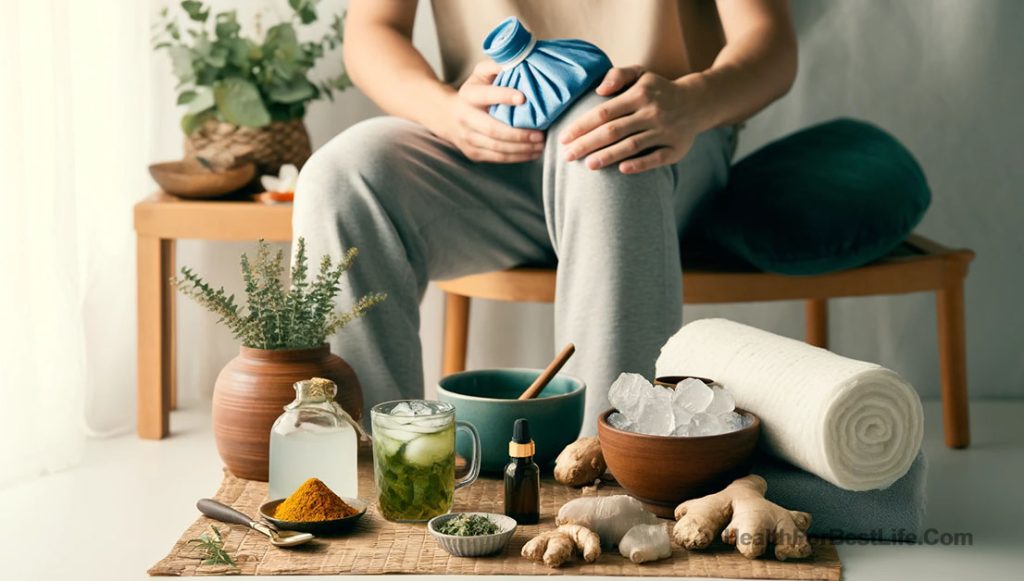Knee Pain Treatment At Home
Are you struggling with knee pain? Whether it’s from a recent injury, the natural wear and tear of aging, or conditions like arthritis, knee pain can really put a damper on your day-to-day activities. But don’t worry, there are several simple strategies you can try at home to help ease the pain and get you moving more comfortably. In this guide, we’ll dive into a variety of home remedies that can make a big difference. Let’s get started on finding the right approach for you!
Comprehensive Guide to Managing Knee Pain at Home

01. Understanding Knee Pain
Knee pain can come from various sources, such as arthritis, injuries, or prolonged stress on the joints. It’s crucial to understand what’s causing your pain to target your treatment effectively. For instance, pain from overuse might respond well to rest and ice, while arthritis pain might need more focused anti-inflammatory interventions.
02. Resting Your Knee
When knee pain strikes, sometimes the best thing you can do is nothing at all. Resting helps prevent further injury and gives your body the time it needs to heal. Give your knee a break from any activity that increases pain, and avoid putting weight on it as much as possible.
03. Applying Ice for Immediate Relief
Ice is a go-to remedy for reducing inflammation and numbing pain. Apply an ice pack wrapped in a cloth to your knee for 20 minutes every hour. Just make sure not to ice for too long, as this can cause frostbite.
04. Compression to Reduce Swelling
Wrapping your knee with an elastic bandage can provide support and help control swelling. The key is to wrap it snugly but not too tight – you don’t want to cut off circulation.
05. Elevate Your Knee to Reduce Swelling
Elevating your knee higher than your heart helps reduce swelling by draining excess fluid. A couple of pillows under your leg should do the trick when you’re lying down.
06. Gentle Stretching Exercises
Stretching can help relieve pain by improving flexibility and reducing tension in the muscles around your knee. Focus on gentle, low-impact stretches that don’t cause pain.

07. Strengthening Exercises to Support the Knee
Strengthening the muscles around your knee can provide better support and reduce stress on the knee joint. Simple exercises like leg raises and wall sits are great for building strength without putting extra strain on your knee.
08. Heat Therapy for Chronic Knee Pain
If your pain isn’t due to recent injury and swelling isn’t a major issue, heat might be more beneficial than ice. Heat can relax and loosen tissues and stimulate blood flow to the area. Use a heating pad or a hot water bottle for about 20 minutes at a time.
09. Over-the-Counter Pain Relief
For those times when you need quick relief, over-the-counter pain relievers like ibuprofen or acetaminophen can be effective. Just be sure to follow the dosage instructions and check with your doctor if you’re taking them regularly.
10. Natural Pain Relief Options
Many people find relief with natural remedies such as turmeric, ginger, and omega-3 fatty acids, all known for their anti-inflammatory properties. Adding these to your diet or taking them as supplements can help manage inflammation and pain.
11. Diet Changes to Support Joint Health
Eating a diet rich in anti-inflammatory foods can help reduce knee pain over time. Focus on incorporating fruits, vegetables, nuts, and whole grains into your meals, and limit processed foods, high-sodium snacks, and sugars.

12. Hydration is Key
Keeping well-hydrated is essential for maintaining the health of your cartilage, which helps cushion your knees. Drink plenty of water throughout the day to keep your joints lubricated.
13. Maintaining a Healthy Weight
Extra weight can put additional pressure on your knees, worsening pain. Managing your weight through diet and exercise can relieve some of this pressure and improve your overall health.
14. Choosing the Right Footwear
Wearing shoes with good support and cushioning can significantly reduce the strain on your knees during daily activities. Avoid high heels and shoes with worn-out soles.
15. Improving Posture and Alignment
Proper body mechanics can take the stress off your knees. Pay attention to your posture when standing and sitting, and use ergonomic furniture that supports your back and legs correctly.
16. Yoga and Mindfulness for Pain Management
Yoga not only helps with flexibility and strength but also focuses on mindfulness, which can help you manage pain better. Gentle yoga poses tailored for knee health can be particularly beneficial.
17. Alternative Therapies: Acupuncture and Massage
Acupuncture and massage therapy can help relieve knee pain for some people. These therapies can reduce tension in the muscles around your knee and improve overall joint function.

18. Regular Check-Ups
Regular visits to your healthcare provider can help you stay on top of your knee health and prevent future issues. Always consult a professional if your knee pain is severe or doesn’t improve with home treatment.
19. Educating Yourself About Knee Health
The more you know, the better you can manage your knee pain. Read up on knee health and stay informed about new treatments and exercises that can benefit you.
20. Community Support
Joining a support group for people with knee pain can provide not only practical advice but also emotional support. Sharing your experiences and learning from others can make managing your knee pain easier.
Conclusion
Managing knee pain at home is totally doable with the right approach. By understanding what causes your pain and exploring these various home remedies, you can find real relief and improve your quality of life. Remember, if your pain is severe or persistent, it’s important to consult with a healthcare professional to rule out more serious conditions. Here’s to better knee health and a more active, pain-free life!

